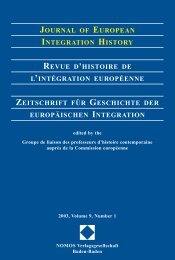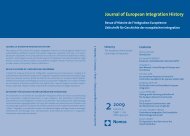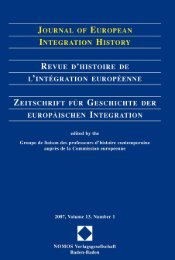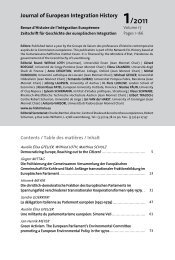journal of european integration history revue d'histoire de l ...
journal of european integration history revue d'histoire de l ...
journal of european integration history revue d'histoire de l ...
Create successful ePaper yourself
Turn your PDF publications into a flip-book with our unique Google optimized e-Paper software.
74<br />
Tapani Paavonen<br />
tra<strong>de</strong> policies, while the subsequent <strong>de</strong>velopment is characterised by consi<strong>de</strong>rable<br />
continuity. World tra<strong>de</strong> liberalisation following the Kennedy (1964-67) and Tokyo<br />
(1973-79) rounds <strong>of</strong> GATT surely mitigated the discernible effects <strong>of</strong> European <strong>integration</strong><br />
<strong>de</strong>cisions.<br />
The most credible explanation for the <strong>de</strong>velopment <strong>of</strong> tra<strong>de</strong> patterns seems to be<br />
that, on one hand, the <strong>integration</strong> <strong>de</strong>cisions created the conditions in which enterprises<br />
gradually <strong>de</strong>veloped their international operations and, on the other, the<br />
gradual internationalisation <strong>of</strong> business practices created pressures for the <strong>integration</strong><br />
policies. In this way the relationship between practised policies and actual economic<br />
<strong>de</strong>velopment seems to have been interactive. Quite obviously, even without<br />
the <strong>integration</strong> <strong>de</strong>cisions the structural <strong>de</strong>velopment would have procee<strong>de</strong>d in the<br />
same direction, but at a consi<strong>de</strong>rably slower pace.<br />
CONCLUSIONS<br />
Finland's participation in the process <strong>of</strong> West European <strong>integration</strong> began with the<br />
en<strong>de</strong>avour to safeguard her relative competitive position in the most important<br />
export markets, but gradually Finland was drawn into an all-embracing economic<br />
and eventually also political <strong>integration</strong> with regard to Western Europe. Participation<br />
in West European <strong>integration</strong> was, without doubt, a precondition for the transformation<br />
<strong>of</strong> Finland, in the same period, from a backward, semi-agrarian country<br />
to an economically advanced industrial society. This <strong>de</strong>velopment can be best interpreted<br />
in the terms <strong>of</strong> the path-<strong>de</strong>pen<strong>de</strong>nce theory, i.e. <strong>integration</strong> has reinforced<br />
institutions that promote economic progress. 41<br />
The first phase <strong>of</strong> Finland's participation in West European <strong>integration</strong> consisted in<br />
free tra<strong>de</strong> in industrial goods within the framework <strong>of</strong> the FINN-EFTA agreement<br />
(1961) and the free tra<strong>de</strong> agreement with the EC (1973). Due to Finland's <strong>de</strong>licate international<br />
position in the circumstances <strong>of</strong> the Cold War, the emergence <strong>of</strong> these agreements<br />
involved consi<strong>de</strong>rable problems with regard to Finland's relationship with the Soviet<br />
Union. A second phase, which consisted in an all-embracing <strong>integration</strong>, started in<br />
the mid-1980s. The new orientation towards reform in the USSR resulted in a consi<strong>de</strong>rable<br />
<strong>de</strong>crease <strong>of</strong> Soviet political obstacles to Finland’s accommodation within the institutionalised<br />
framework <strong>of</strong> West European <strong>integration</strong> and, eventually, as the result <strong>of</strong><br />
the collapse <strong>of</strong> the Soviet Union, they were abolished.<br />
40. Relevant statistical indicators are: GL indices for intra-industry tra<strong>de</strong> (figure 3); imports <strong>de</strong>pen<strong>de</strong>nce<br />
by industries, P. AHDE, Tuonnin merkitys Suomen kansantalou<strong>de</strong>lle ja viennille, Helsinki,<br />
1990, pp.77-81; χ 2 values for transformation <strong>of</strong> internal industrial structures within different periods,<br />
T. TOIVONEN, Rakennemuutos 1930-1985. Aineistoa toimiala-, luokka- ja kerrostumarakenteen<br />
tutkimukseen, Turku, 1988, repr.1990, pp.72-74.<br />
41. See spec. D.C. NORTH, Economic Performance Through Time, in: The American Economic Review,<br />
Vol.84, No.3, 1994, pp.363-366.

















